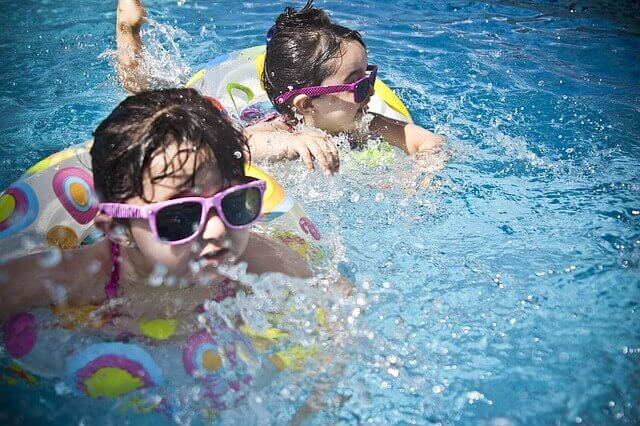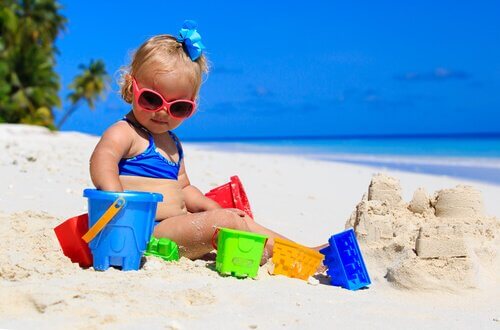Choosing Sunglasses for Kids: What You Need to Know

Children’s eyes are very sensitive to the sun, and they often don’t appropriately protect them. Just like their skin, it’s essential to protect children’s eyes from UV rays by using appropriate sunglasses for kids.
Children’s eyes are certainly very fragile. Until around age 10-12, the lens, which is the main protection for the the retina against UV rays, doesn’t yet fulfill this function and lets in 7 times more UV rays than adult eyes.
Likewise, just as sunscreen has become an automatic system for protecting children’s skin, quality sunglasses are equally essential to protect their eyes.
Help your children get used to wearing them from a young age. This will help protect them from more serious eye problems later on.
Don’t forget that sunglasses should also be comfortable. In other words, they should be adapted to the shape of a child’s face. If not, they’ll irritate children’s noses and they may refuse them.
Sunglasses for kids
Sunglasses are essential for children from an early age, given that their retinas are fragile and need to be protected. However, it’s true that there are still too many parents who aren’t aware of this.
In fact, children are more sensitive to UV radiation until they’re about 12 years old. In summer, children regularly face these UV rays, especially when they’re reflected by the water, sand, or grass.
These can potentially damage children’s eyes. Just like skin, eye burns from the sun can cause long-term damage.
Additionally, remember that when you’re choosing a pair of sunglasses for your child, it’s important to ask your child about the fit and ensure that they’re correctly placed on their nose without being uncomfortable.

Choosing the right sunglasses for kids
When it comes to choosing the ideal sunglasses for kids, keep the following tips in mind, according to your child’s age.
For children ages 0 to 5 years
Plastic frames are the best choice. This material is hypo-allergenic and ensures a better weight distribution on the nose. They also don’t bend or break.
For ages 5 to 10
For this age group, choose sunglasses that are: strong, practical, and aesthetically pleasing. The choice of material isn’t really important, as there are many options.
“Just as sunscreen has become an automatic system for protecting children’s skin, quality sunglasses are equally essential to protect their eyes.”
Things to keep in mind when choosing sunglasses
1. Protection
To protect children’s eyes, the lenses must completely filter out all UV rays. First, check for the mark CE. This is a European protection standard and should appear on the glasses you choose.
Also choose the protection index of the glass. The index is usually indicated on the arm of the glasses or on a sticker on the lenses when you buy them.
The protection grade will be between 0 and 4. Don’t use sunglasses with a protection classification less than 4 for children.
2. Frames
Children’s sunglasses are usually designed for comfort. However, some models are definitely better than others. To choose the ideal model, be careful to choose a brand that is appropriate for the child’s age.
Likewise, the glasses should always match your child’s face shape and should be tall enough so that they can’t look below or above the glasses.
3. Lenses
Scratch-resistant lenses aren’t infallible. If they get scratched, change them quickly so they don’t affect your child’s vision.
4. Safety
Safety is the most important criterion and is determined by the strength of the frames and the lenses. Don’t skimp on the price of the glasses.

Advice for getting your child used to sunglasses
If you notice that your child has difficulty getting used to wearing sunglasses, here are a few tips to keep in mind:
- Wear sunglasses yourself: kids love to imitate adults!
- Show them how much more comfortable it is to wear sunglasses when it’s sunny out.
- If children want to wear them in the house, teach them that they aren’t a toy and show them how to take care of them.
- For kids who resist wearing sunglasses, check whether the frames are comfortable.
Finally, remember that there are many different materials and models to choose from: plastic, acetate, or metal, available in infinite colors. The most important thing is that they fit your child’s face and are designed not to hurt your child in case of an accident.
Children’s eyes are very sensitive to the sun, and they often don’t appropriately protect them. Just like their skin, it’s essential to protect children’s eyes from UV rays by using appropriate sunglasses for kids.
Children’s eyes are certainly very fragile. Until around age 10-12, the lens, which is the main protection for the the retina against UV rays, doesn’t yet fulfill this function and lets in 7 times more UV rays than adult eyes.
Likewise, just as sunscreen has become an automatic system for protecting children’s skin, quality sunglasses are equally essential to protect their eyes.
Help your children get used to wearing them from a young age. This will help protect them from more serious eye problems later on.
Don’t forget that sunglasses should also be comfortable. In other words, they should be adapted to the shape of a child’s face. If not, they’ll irritate children’s noses and they may refuse them.
Sunglasses for kids
Sunglasses are essential for children from an early age, given that their retinas are fragile and need to be protected. However, it’s true that there are still too many parents who aren’t aware of this.
In fact, children are more sensitive to UV radiation until they’re about 12 years old. In summer, children regularly face these UV rays, especially when they’re reflected by the water, sand, or grass.
These can potentially damage children’s eyes. Just like skin, eye burns from the sun can cause long-term damage.
Additionally, remember that when you’re choosing a pair of sunglasses for your child, it’s important to ask your child about the fit and ensure that they’re correctly placed on their nose without being uncomfortable.

Choosing the right sunglasses for kids
When it comes to choosing the ideal sunglasses for kids, keep the following tips in mind, according to your child’s age.
For children ages 0 to 5 years
Plastic frames are the best choice. This material is hypo-allergenic and ensures a better weight distribution on the nose. They also don’t bend or break.
For ages 5 to 10
For this age group, choose sunglasses that are: strong, practical, and aesthetically pleasing. The choice of material isn’t really important, as there are many options.
“Just as sunscreen has become an automatic system for protecting children’s skin, quality sunglasses are equally essential to protect their eyes.”
Things to keep in mind when choosing sunglasses
1. Protection
To protect children’s eyes, the lenses must completely filter out all UV rays. First, check for the mark CE. This is a European protection standard and should appear on the glasses you choose.
Also choose the protection index of the glass. The index is usually indicated on the arm of the glasses or on a sticker on the lenses when you buy them.
The protection grade will be between 0 and 4. Don’t use sunglasses with a protection classification less than 4 for children.
2. Frames
Children’s sunglasses are usually designed for comfort. However, some models are definitely better than others. To choose the ideal model, be careful to choose a brand that is appropriate for the child’s age.
Likewise, the glasses should always match your child’s face shape and should be tall enough so that they can’t look below or above the glasses.
3. Lenses
Scratch-resistant lenses aren’t infallible. If they get scratched, change them quickly so they don’t affect your child’s vision.
4. Safety
Safety is the most important criterion and is determined by the strength of the frames and the lenses. Don’t skimp on the price of the glasses.

Advice for getting your child used to sunglasses
If you notice that your child has difficulty getting used to wearing sunglasses, here are a few tips to keep in mind:
- Wear sunglasses yourself: kids love to imitate adults!
- Show them how much more comfortable it is to wear sunglasses when it’s sunny out.
- If children want to wear them in the house, teach them that they aren’t a toy and show them how to take care of them.
- For kids who resist wearing sunglasses, check whether the frames are comfortable.
Finally, remember that there are many different materials and models to choose from: plastic, acetate, or metal, available in infinite colors. The most important thing is that they fit your child’s face and are designed not to hurt your child in case of an accident.
This text is provided for informational purposes only and does not replace consultation with a professional. If in doubt, consult your specialist.








